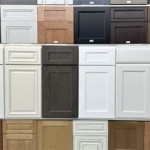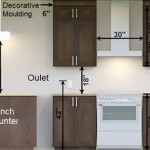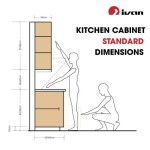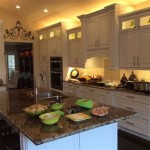Wooden Handles: Enhancing Kitchen Cupboards with Natural Elegance
Kitchen cupboards are fundamental elements in any culinary space, providing storage and contributing significantly to the overall aesthetic. Beyond their functional purpose, cupboards offer an opportunity to express personal style and enhance the kitchen's visual appeal. A crucial detail often overlooked is the selection of handles. Among the diverse options available, wooden handles offer a unique blend of warmth, durability, and timeless elegance, making them a popular choice for homeowners seeking to elevate their kitchen design.
The use of wood in interior design has a long and storied history. Its natural beauty, versatility, and inherent character make it a favored material for various applications, from flooring and furniture to decorative accents. Wooden handles for kitchen cupboards capitalize on these inherent qualities, introducing a touch of nature into the heart of the home. They can complement a wide range of design styles, from traditional and rustic to contemporary and minimalist, offering a customizable element that can significantly impact the overall ambiance of the kitchen.
Choosing the right handles for kitchen cupboards is not merely a cosmetic decision; it is an investment in the long-term functionality and aesthetic appeal of the space. Wooden handles, in particular, offer several advantages that make them a compelling choice for homeowners seeking to create a kitchen that is both beautiful and practical.
Aesthetic Versatility and Design Harmony
One of the primary benefits of wooden handles is their exceptional aesthetic versatility. Wood, in its natural state, possesses a warmth and character that synthetic materials often lack. This inherent quality allows wooden handles to seamlessly integrate into a variety of kitchen styles, creating a cohesive and harmonious design.
In traditional kitchens, wooden handles can enhance the classic charm and timeless appeal of the space. Paired with Shaker-style cabinets and warm color palettes, wooden handles can evoke a sense of heritage and sophistication. Finishes such as stained oak or cherry provide a rich and inviting aesthetic, complementing the natural grain and enhancing the overall richness of the design.
In rustic kitchens, wooden handles can contribute to the natural and organic feel of the space. Utilizing wood with pronounced grain patterns and knots can accentuate the rustic aesthetic, creating a sense of authenticity and connection to nature. Options such as reclaimed wood or distressed finishes can further enhance this effect, adding character and visual interest to the cupboards.
Even in contemporary kitchens, wooden handles can find their place, adding a touch of warmth and texture to the sleek and minimalist lines that often characterize this style. Choosing handles with clean, simple designs and a smooth finish can create a subtle yet impactful contrast against the clean lines of modern cabinetry. Lighter woods, such as maple or birch, can be particularly effective in these settings, providing a visual counterpoint to the often-stark color palettes of contemporary kitchens.
Beyond the overall style of the kitchen, wooden handles can also be chosen to complement other design elements within the space. Matching the wood type and finish of the handles to the flooring, countertops, or other wooden accents can create a sense of continuity and visual harmony. This coordinated approach can elevate the overall design, creating a cohesive and well-balanced aesthetic.
Durability and Longevity
Another significant advantage of wooden handles is their inherent durability and longevity. Wood, when properly treated and maintained, is a robust and resilient material that can withstand the rigors of daily use in a busy kitchen. High-quality wooden handles are built to last, providing homeowners with a long-term investment in the functionality and aesthetic appeal of their kitchen.
The durability of wooden handles is influenced by several factors, including the type of wood used, the quality of the finish, and the level of maintenance provided. Hardwoods, such as oak, maple, and cherry, are generally more durable than softwoods, such as pine or cedar. Hardwoods are denser and less prone to dents, scratches, and other forms of damage, making them an excellent choice for high-traffic areas like kitchen cupboards.
The finish applied to wooden handles also plays a crucial role in their durability. A high-quality finish can protect the wood from moisture, stains, and UV damage, extending its lifespan and preserving its aesthetic appeal. Options such as varnish, lacquer, and polyurethane provide a protective barrier that shields the wood from the elements, preventing it from warping, cracking, or fading over time.
Proper maintenance is essential for ensuring the long-term durability of wooden handles. Regular cleaning with a mild soap and water solution can remove dirt, grease, and other contaminants that can damage the finish and weaken the wood. Avoid using harsh chemicals or abrasive cleaners, as these can strip the finish and scratch the surface of the handles. Periodic reapplication of the finish may also be necessary to maintain its protective qualities and prevent the wood from drying out.
Compared to handles made from other materials, such as metal or plastic, wooden handles offer a unique combination of durability and aesthetic appeal. While metal handles may be more resistant to certain types of damage, they can also feel cold and sterile to the touch. Plastic handles, on the other hand, may be more affordable but often lack the durability and aesthetic appeal of wood. Wooden handles strike a balance between these two extremes, providing a durable and visually appealing option that can enhance the overall quality and longevity of the kitchen.
Tactile Comfort and Ergonomic Design
Beyond their aesthetic and durability, wooden handles offer a unique tactile comfort and ergonomic design that can enhance the user experience in the kitchen. The natural warmth and texture of wood provide a pleasant and comfortable grip, making it easier and more enjoyable to open and close cupboards. This tactile quality can contribute to a more positive and overall satisfying experience in the kitchen.
The ergonomic design of wooden handles can also play a significant role in their functionality. Handles that are properly sized and shaped can reduce strain and fatigue, making it easier to access the contents of the cupboards. Consider the size and shape of the handles carefully, taking into account the size and weight of the cupboard doors and the individual preferences of the user. Handles that are too small or too awkwardly shaped can be difficult to grip, while handles that are too large or bulky can be cumbersome and uncomfortable.
Various handle designs cater to different ergonomic preferences and functional needs. Pull handles, for example, are typically used on drawers and lower cabinets, providing a comfortable and easy-to-grip option for opening and closing these storage spaces. Knobs, on the other hand, are often used on upper cabinets, offering a more discreet and minimalist aesthetic. Lever handles are another option, providing a more ergonomic grip for individuals with limited hand strength or mobility.
The type of wood used can also influence the tactile comfort of the handles. Smooth, finely sanded woods, such as maple or birch, provide a pleasant and comfortable grip, while woods with more pronounced grain patterns and textures can offer a more tactile and engaging experience. Consider the overall texture and feel of the wood when selecting handles, choosing options that complement the overall design and enhance the user experience.
The choice of finish can also affect the tactile comfort of wooden handles. A smooth, matte finish provides a comfortable and non-slip grip, while a glossy finish can be more slippery and less comfortable to hold. Consider the overall texture and feel of the finish when selecting handles, choosing options that provide a comfortable and secure grip.

Handling Kitchen Handles Door Modern Wooden Cabinets

Double Grip Square Edge Wooden Door Handles In Plywood For

Design Idea Oversized Wood Knobs On Cabinets

Kitchen Cabinet Handles Pictures Options Tips Ideas

Oak Wood Drawer Handles Modern Cabinet Pulls Kitchen

Advantages And Disadvantages Of Wooden Cabinet Knobs

Kitchen Door Handles Next Day Delivery Lark And Larks

How To Choose The Right Cabinet Handles Knobs For Your S

The Warmth Of Wooden Cabinet Pulls Kitchen Inspirations Interior Design
:max_bytes(150000):strip_icc()/easy-steps-to-install-cabinet-hardware-1822225-07-0a31994a76dd450ba41b2ba2ba6e3d59.jpg?strip=all)
How To Select Cabinet Knobs And Pulls
Related Posts








